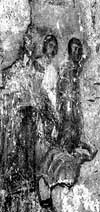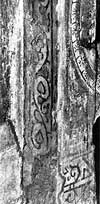| Виртуальный Владимир » Город Владимир » Old Russian Towns » Suzdal » Historic buildings » Church oi St. Boris and St. Gleb » frescoes |
 ...
... frescoes
frescoes 18th centuries buildings
18th centuries buildings The church appears to have remained unpainted for some thirty or forty years after it was built. During this period its interior had the same austere appearance as the outside, relieved only by the icons on the altar screen. A number of specialists date the fragments of frescoes discovered in 1947 to the 1180s. It is quite possible that they were commissioned by Vsevolod III in honour of his father, who had built the royal residence at Kideksha, and his Greek mother, a princess of the Comnenian dynasty. She is depicted in the fresco of the burial niche in the north wall wearing sumptuous imperial robes next to the figure of St. Mary, the name of Prince Boris' wife who is also buried here. The large, impressive figures in bright crimson robes stand out clearly against a white background surrounded by palms with red fruit and trees with two peacocks evidently depicting the Garden of Paradise. It is interesting that the walls of the choir-gallery where the royal family stood during services were also decorated with trees and birds in pinkish reds and violets, i.e., pictures of Paradise, contrary to the strictly prescribed canons of fresco painting. This passion for brightly coloured decoration was developed in the frescoes of the thirteenth-century Suzdal cathedral, as we have already seen. Excavations in the central apse have revealed a painted frieze of curtains with yellow folds and reddish brown seven-branched candelabra and trees, as well as a semi-circular stone seat for the priests. The remaining frescoes are on the south and west walls by the new iconostasis. The decoration on the round medallion and the surfaces of the pilaster strip on the north wall are particularly interesting. Fragments of various compositions have survived on the south wall, including the figures of two horsemen. Some experts claim that they are Boris and Gleb, but it seems more likely that they represent the Magi. Reddish browns dominate in the frescoes giving them a restrained colour scheme.
The church appears to have remained unpainted for some thirty or forty years after it was built. During this period its interior had the same austere appearance as the outside, relieved only by the icons on the altar screen. A number of specialists date the fragments of frescoes discovered in 1947 to the 1180s. It is quite possible that they were commissioned by Vsevolod III in honour of his father, who had built the royal residence at Kideksha, and his Greek mother, a princess of the Comnenian dynasty. She is depicted in the fresco of the burial niche in the north wall wearing sumptuous imperial robes next to the figure of St. Mary, the name of Prince Boris' wife who is also buried here. The large, impressive figures in bright crimson robes stand out clearly against a white background surrounded by palms with red fruit and trees with two peacocks evidently depicting the Garden of Paradise. It is interesting that the walls of the choir-gallery where the royal family stood during services were also decorated with trees and birds in pinkish reds and violets, i.e., pictures of Paradise, contrary to the strictly prescribed canons of fresco painting. This passion for brightly coloured decoration was developed in the frescoes of the thirteenth-century Suzdal cathedral, as we have already seen. Excavations in the central apse have revealed a painted frieze of curtains with yellow folds and reddish brown seven-branched candelabra and trees, as well as a semi-circular stone seat for the priests. The remaining frescoes are on the south and west walls by the new iconostasis. The decoration on the round medallion and the surfaces of the pilaster strip on the north wall are particularly interesting. Fragments of various compositions have survived on the south wall, including the figures of two horsemen. Some experts claim that they are Boris and Gleb, but it seems more likely that they represent the Magi. Reddish browns dominate in the frescoes giving them a restrained colour scheme.
 Vsevolod III appears to have decorated the church with more than frescoes. Excavations in the central apse revealed fragments of a white stone ciborium which stood over the altar and was embellished with beautiful carving reminiscent of the flat carving on the Cathedral of St. Dmitri.
Vsevolod III appears to have decorated the church with more than frescoes. Excavations in the central apse revealed fragments of a white stone ciborium which stood over the altar and was embellished with beautiful carving reminiscent of the flat carving on the Cathedral of St. Dmitri.
There is no trace of an entrance into the choir-gallery and we do not know how it was reached. It has been suggested that a wooden staircase led from the inside of the church to the north vault of the gallery. The church was part of the royal residence. Future excavations may well throw more light on the original topography of the residence of Prince Yuri Dolgoruky and his son Boris.
Оставить комментарий:



 Виртуальный Владимир
Виртуальный Владимир Область
Область Панорамы города
Панорамы города Организации
Организации Улицы и дома
Улицы и дома Добавить организацию
Добавить организацию О городе
О городе










